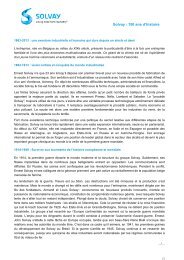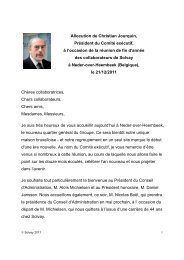solvay_live243_p02a04 somEdito
solvay_live243_p02a04 somEdito
solvay_live243_p02a04 somEdito
Create successful ePaper yourself
Turn your PDF publications into a flip-book with our unique Google optimized e-Paper software.
Dossier SolvayInnovationTrophy2006<br />
103515<br />
28<br />
SOLVERA ® : NEW PRODUCTS<br />
FOR GREASE PROOF PAPER<br />
AN END TO TOXIC<br />
ACCUMULATION<br />
Fluorochemicals are used to make paper<br />
greaseproof, mainly in the food packaging<br />
industry. In 2000, 3M withdrew from<br />
this international market following the<br />
discovery of a persistent degradation product<br />
that was also bio-accumulative and toxic.<br />
Suddenly, bright new opportunities arose<br />
for newcomers. Using PFPE (perfluoropolyethers),<br />
the chemists at Solvay Solexis designed<br />
a new molecular structure capable of meeting<br />
the following demands :compatibility with<br />
existing paper chemistry and application<br />
methods, the capacity to homogeneously cover<br />
the porous substrate without any pin holes,<br />
a toxicological profile sound enough to fulfil<br />
the demands of the Food and Drug Administration<br />
and proven safety of the degradation products.<br />
All these properties had to be combined<br />
with impermeability to oil and water, in line<br />
with the needs of the market. Three products<br />
were thus developed under the Solvera PT<br />
range. At the same time, the industry needed<br />
new testing methods that would allow them<br />
to quickly evaluate the real resistance<br />
of the paper during the production process.<br />
Solvay Solexis developed these new test<br />
methods and they have since been adopted<br />
by the main players in the sector.<br />
These innovative products give Solvay Solexis<br />
a decisive competitive edge thanks<br />
to its inimitable technological platform<br />
and the high degree of process integration.<br />
The innovations have allowed this type<br />
of paper to escape the vicious cycle<br />
of toxic bio-accumulation. .<br />
> Piero Gavezotti; Fiorenza Daprile; Antonella Di Meo;<br />
Padigala Mahesh; Claudio Tonelli; Tania Trombetta.<br />
> SBU SPECIALTY POLYMERS<br />
104425<br />
HIGH PURITY BARIUM CARBONATE COATED<br />
WITH TITANIUM DIOXIDE : A NEW APPROACH<br />
TO THE SYNTHESIS OF ELECTRONIC MATERIALS<br />
NEW DEVELOPMENTS<br />
FOR CAPACITORS<br />
The innovation covers a powder known as<br />
BaCO3 HP FC, which includes a core of high<br />
purity barium carbonate and a shell of titan<br />
dioxide, and also its method of production.<br />
This powder is used as a basic ingredient for<br />
the solid state production of high crystalline<br />
barium titanate. The traditional procedure<br />
involves mixing and grinding of mixtures<br />
of barium carbonate and titanium dioxide<br />
followed by an high temperature calcination.<br />
The new procedure strongly improves<br />
the mixing of the reactants, which<br />
subsequently triggers a better and faster<br />
reaction. With the BaCO3 HP FC, the<br />
electronic industry can manufacture better<br />
performing barium titanate and, in turn,<br />
better ceramic capacitors. This approach<br />
permits a more cost effective production<br />
of high end ceramic capacitors, extending<br />
their market share against other types<br />
of capacitors. Finally, this innovation leads<br />
to an increase in the barium titanate market<br />
and broadens the scope of the barium<br />
carbonate. The Institute of Energetics and<br />
Interphases at the Italian National Research<br />
Council participated in the project in 2004 and<br />
2005. The product will be manufactured<br />
in a specially adapted plant. Production is set<br />
to be launched in 2006 and sales in 2007.<br />
> Rocco Alessio; Maria Teresa Buscaglia;Vincenzo Buscaglia;<br />
Arianna Daquino; Sara Trombella.<br />
> SBU BARIUM-STRONTIUM<br />
104530<br />
MULTIPURPOSE PLANT FOR FLUORINATED<br />
CF3 AND CF2-SPECIALTIES<br />
THE SWISS KNIFE<br />
OF THE PHARMACEUTICAL<br />
INDUSTRY<br />
It is a broadly accepted fact that one in every<br />
three new pharmaceutical or agronomic<br />
projects contains a fluorine atom. Solvay has<br />
earned an envied reputation and leadership<br />
position on the fluorinated specialties market<br />
but it is a cost conscious and competitive<br />
market. To increase cost-effective flexibility<br />
and reduce the financial risk associated with<br />
the construction of dedicated new plant, Solvay<br />
had the idea of designing a multipurpose plant<br />
for fluorinated specialties. This called for the<br />
pooling of a broad spectrum of skills. The plant<br />
was built in Bad Wimpfen (Germany),<br />
a wine-growing region that imposes strict<br />
environmental protection rules. All these<br />
regulations were respected and the relationship<br />
with the plant’s neighbours and the local<br />
authorities is constantly nurtured. Built in 2002<br />
the plant sets out to make a contribution<br />
of around MEUR 3.5 to the sales of the SBU<br />
now in 2006. This figure should reach MEUR 20<br />
in 2010 if we take into account the projects<br />
currently under development. Several<br />
compounds have already been delivered from<br />
this multi-purpose installation: intermediate<br />
fluorinated products for Pfizer, Eli Lilly,<br />
Sanofi-Adventis, Esteve, Cenral Glass, Lonza,<br />
Dow and others and more recently, a new<br />
herbicide was developed in cooperation with<br />
Dow Agro.<br />
> Ern Edmonds; Max Braun; Francine Delplanque;<br />
Johannes Eicher; Ralf Herkelmann; Matthias Lipp.<br />
> SBU MOLECULAR SOLUTIONS<br />
New business


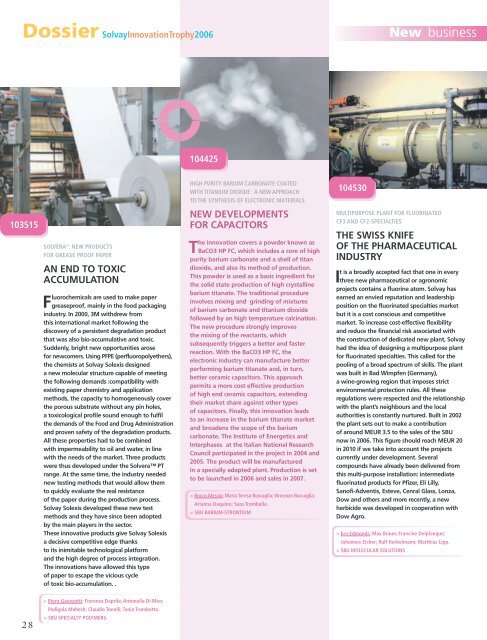

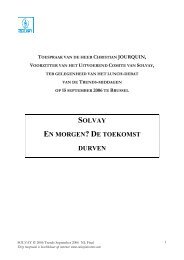
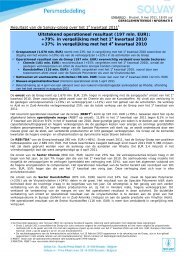

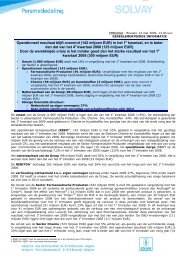
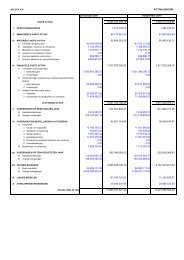

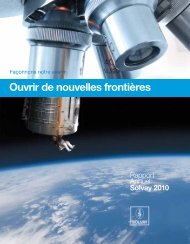
![PROC.1 [LETTRE] - Solvay](https://img.yumpu.com/16585746/1/184x260/proc1-lettre-solvay.jpg?quality=85)
